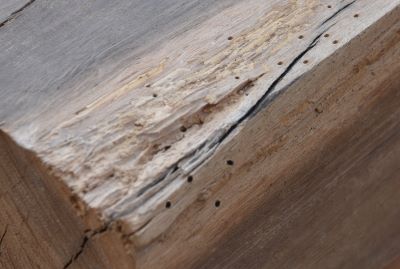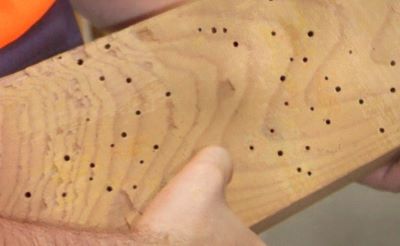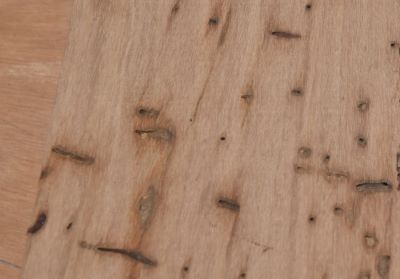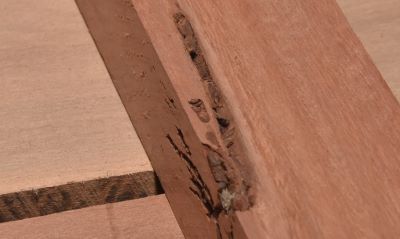Borers
Borers are beetles, which at some stage of their development bore into wood for food or shelter.
Particular species of borers can have a serious effect on the strength of timber, and in these cases there are specific building regulations designed to reduce the chance of particular types of attack. The regulations vary from one region to another, and also from state to state, depending on the likelihood of attack in that locality.
Below are the most common borers affecting timber.
Lyctid borers

you can see that they are only present
in the sapwood of this spotted gum
Lyctid borers are also called powder post beetles. They attack only the sapwood of particular hardwood species. The female beetles lay their eggs beneath the surface of the wood by inserting their ‘ovipositor’ into the pores.
If the pores of a particular species are too small for the ovipositor, then that species is immune from attack. Because softwoods don’t contain pores, they are all immune from attack.
See Section 1, particularly the lesson Softwoods and hardwoods, for more information on the cell structure of wood.
Anobium borers

The most common type of anobium borer in Australia is the furniture beetle. This beetle prefers damp, humid conditions and is a particular problem in old furniture, especially in softwoods species.
It’s also known to attack baltic pine flooring in houses with poor sub-floor ventilation. In Queensland, the hoop pine borer, also from the anobium family, is sometimes found in hoop and kauri pine.
Ambrosia borers

shown both vertically (round holes)
and longitudinally (across the surface)
Ambrosia borers are more commonly known as pin hole borers. The female bores a long straight hole into the wood to deposit its eggs, and then coats the walls of the hole with ambrosia fungi to provide a food source for the larvae when they hatch.
This is why the holes generally have a characteristic blackish stain around them when the timber is sawn. Pin hole borers only attack living tress and freshly felled logs, since the ambrosia fungi need a high moisture content to survive.
Longicorn borers

shown as a longitudinal tunnel
Longicorns are a forest problem, rather than a dry timber problem. They generally attack hardwoods, and drill oval shaped holes up to 10 mm in diameter, although sometimes the holes can be larger. Longicorns include the witchetty grub varieties.